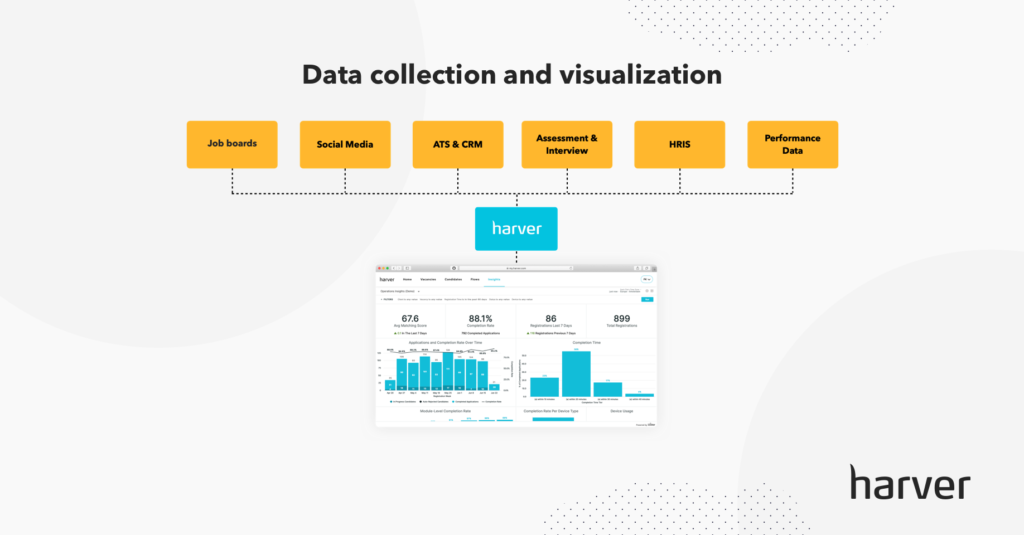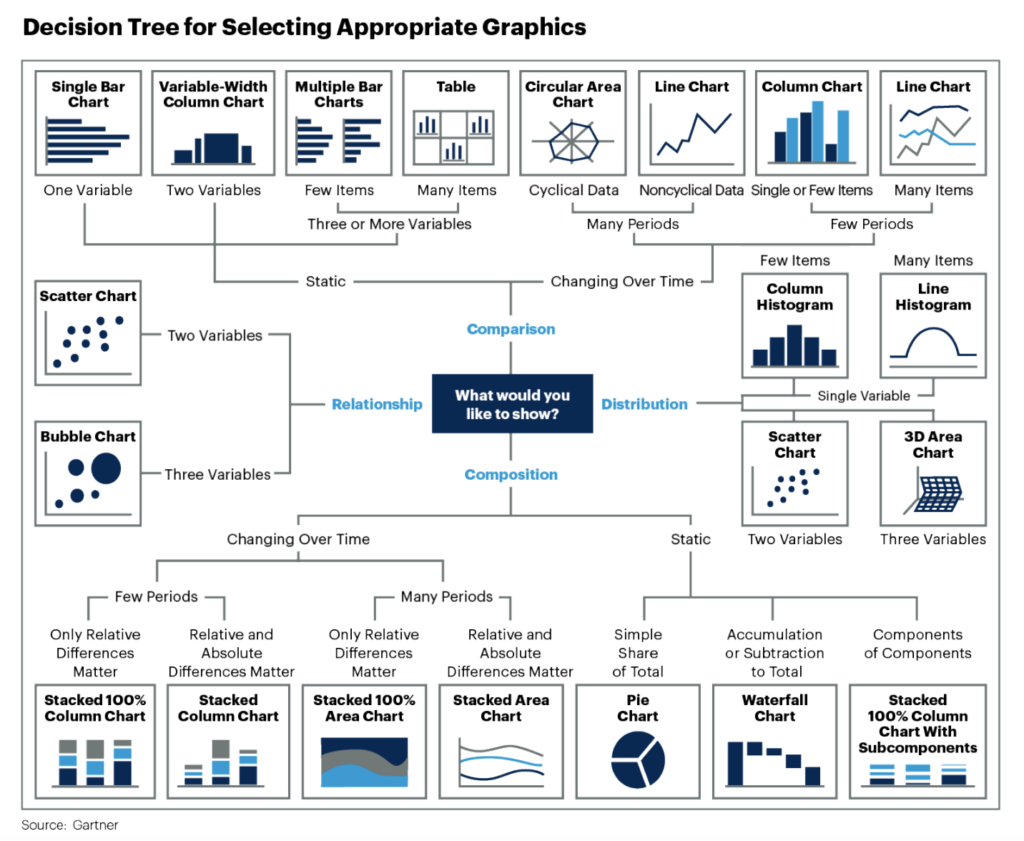While talent analytics at its core is a great idea, we’ve found too often companies collect tons of data without actually needing it, or without knowing what to do with it or how to interpret it.
In 2016, only 8% of companies had a strong talent analytics function. Today, that figure is slightly higher at 29%, meaning there is still a lot of room for improvement. But according to Deloitte research, only 4% of organizations have predictive talent analytics capabilities.
What’s needed is a better understanding of talent analytics and how to make the data work for you.
So, to help you get started, in this article we’ll delve into what talent analytics is, what types of data one should collect, as well as share some visualization methods to help you improve your recruitment process.
What’s in?
Like what you see?
Don’t miss out. Subscribe to our quarterly digest to get the latest TA and TM resources delivered right to your inbox.
What is talent analytics
Put simply, talent analytics – also referred to as workforce analytics, human capital analytics, or human resource analytics – is the analysis of employee data, facilitated by the use of statistics and tech, with the purpose of making better business decisions.
It typically involves the use of software that gathers insights into a company’s current workforce and potential employees, allowing talent acquisition teams to understand what motivates their workers and potential hires. That’s in addition to getting a better understanding of their strengths and weaknesses. All of this info is essential for adopting strategies that improve performance and productivity.
Does talent analytics make a real difference? Well, Bain & Company research found a 40% disparity between the productivity of organizations who’d invested in talent focused analytics, and the rest.
Why such a gap? Because talent analytics can help increase employee productivity by balancing efficiency with employee engagement. It addresses the biases, and measures the things that matter most to your business.
But in order for analytics to be beneficial i.e. help recruiters make better hiring decisions, talent acquisition teams need to know what type of talent data they should be collecting in the first place.
What types of talent data you should collect
Using a data-driven recruitment approach can help you increase your quality of hire, decrease the cost of hire and early attrition rates, and increase employee engagement and satisfaction.
However, despite the numerous benefits of data-driven recruitment, it is still common – especially in the volume hiring space – for HR departments to habitually collect vast amounts of data, the majority of which goes unused. This happens mainly because of outdated processes, a lack of skills, or no clear overview of the bigger picture.
So, what types of talent data should you collect when implementing a talent analytics solution? We’ve divided the different types of data into categories to help you structure your approach and get you started:
Sourcing data
In volume recruiting, you need to track multiple data sources to enable the TA team to make hiring decisions. Sourcing data you should be collecting includes data from:
Job boards
Tracking data from job boards will give you a better insight into how your adverts are performing.
For example: How many applicants are you getting? Which job boards yield the most candidates? Where are the top candidates coming from? Which job boards deliver the best ROI? What devices are applicants applying from? What are their demographics? Their locations? How many people are seeing your job advert? What’s the cost per application?
Social media
Social media is a great way to connect with younger applicants, but you need to track data to know if your recruitment strategy is working.
For example: Which channels are the most effective? Which channel yields the top candidates? How many candidates does each channel generate? What’s your cost per hire capture?
ATS (applicants tracking system) data
The reason for having a talent pool is so you don’t have to constantly source new candidates. A smart ATS will instantly match suitable candidates to open roles. But to do that, your ATS needs to track data such as: where have applicants come from? What role did they apply for? Where are they at in your application process?
CRM (candidate relationship management) data
To consistently deliver outstanding candidate experience when volume recruiting thousands of applicants quickly and efficiently, requires CRM data.
Data to track includes: application abandonment rate, where candidates drop out of the application, how many candidates are in your pipeline and talent pools, how long applicants are spending at each stage of the application, cost to hire, time to hire, time to commitment, quality of hire, referral rate etc.
Recruitment analytics data
Manually screening resumes and sifting candidates by hand introduces bias into the hiring process, not to mention being a colossal waste of recruiters’ time. So what’s the alternative?
To use recruitment tools that have built-in reporting functionality. Especially in volume hiring, it’s critical to have real-time data on matching results, automated decision points, and candidate experience data, all in one place to break down the silos between phases of the hiring process.
The Harver platform, for example, brings data from the entire hiring process together and creates a command center for all things hiring. Whether it’s sourcing data coming from job boards or social media job listings, assessment and interview data, or performance data, all the information is collected into a single source of truth, making it easy to see the full picture of your recruitment process and to spot inefficiencies.
In general, when it comes to recruitment analytics, you want to collect data that gives you:
- operational insights, to understand how efficient your process is and where the bottlenecks are
- hiring insights, to understand why candidates drop off, and which parts of the process require improvements
- personality insights, to understand what types of candidates apply to your open roles, and compare them to your top performers
- matching or scoring insights, for assessment results
- multi-location insights, as these help you understand if you need to route candidates between locations, for example, or to better equip your hiring managers in a specific area
- candidate experience insights, to understand how your brand and application process is perceived
Don’t forget to collect data from in-person interviews too. For example, how long did it take for successful candidates to reach this stage? How effective are your interviewers? Are your interviews consistent?

Employee data
Data collection doesn’t stop once you’ve hired candidates. Employee data provides recruiters with a check in opportunity to make sure the recruitment process is working as it should be. Employee data will yield results allowing you to tweak the hiring process where required
For example, if after 6 months of employment it turns out that 85% of top performing hires scored highly on culture fit, say, that might mean you weigh the preselection process to favor candidates who also score highly on culture fit.
While employee data will vary with your industry, in general, data you might want to track can include: employee attrition rate, employee satisfaction, employee engagement, benefit participation rates, etc.
How to visualize your talent data
How you represent the data will depend on the answer to one simple question: what would you like the data to show?
- Is it a comparison?
- Are you highlighting a relationship?
- Are you demonstrating composition?
- Are you showing distribution of items or variables?
Of course, the different types of visualizations and dashboards you’ll need will vary depending on your overall business goals and KPIs. Below you can see a decision tree from Gartner that can help you decide how to represent your data.

Data visualization with Harver
When you’re operating at scale and carrying out volume hiring routinely, having reams of data is one thing, but being able to visualize the results in one place is key to making fast and efficient decisions.
For this reason, deciding which system will be your single source of truth is possibly the most crucial part of collecting and analyzing data. And that’s because effective data visualization is incredibly powerful, while poorly visualized data will only make volume hiring harder. It will confuse viewers, send the wrong messages, enable biased decision making, and fail to make an impact.
The problem, however, is that too many organizations who try to do talent analytics, struggle with data visualization. Data is, after all, only valuable if it’s easy to use and easily actionable.
Harver, for example, includes a self-service analytics suite called Insights, powered by Looker on Google Cloud.
It streamlines all data collection from across every channel and platform, from job boards to interviews. It then amalgamates all candidate selection data into one single source of truth that every member of the TA team has access to. You can learn more about it by watching our webinar below.
While our solution is one way of visualizing data, how you require your talent analytics to be visualized will depend on what your desired outcome is.
For example, if you’re collecting candidate assessment scores, you’ll want the data to show those candidates who reach your benchmark, automatically triggering their autoprogress to the next stage of your funnel. Or if you’re collecting data on time to commitment, you could use it to highlight the bottlenecks in the process, the places you need to invest time or money to speed up the flow.
Common mistakes to avoid
Badly visualized data isn’t the only mistake TA teams make doing talent analytics. We’ve compiled a quick list of common mistakes we’ve seen, so you can avoid doing them.
Not asking ‘why’ before working on talent analytics
Before you begin collecting and analyzing talent data, be sure you have a solid understanding of why you’re doing it. What is the goal? How will the whole organization profit from your efforts?
Without a clear vision of why you’re doing talent analytics, you can get lost down rabbit holes of needless data.
Ignoring legal risks
Talent analytics is all about data. And the rules around personal data are stringent. If you take a risk with people’s privacy, you could find yourself in hot water. Be very aware of the rules and laws you need to comply with before collecting or analyzing any personal data.
Not matching your data visualization to the audience
Talent analytics isn’t just beneficial for the TA team. The range of stakeholders likely extends beyond the borders of the HR department. Therefore don’t implement a data visualization solution that solely suits recruiters.
At the same time, while it might be tempting to implement a solution that enables even the least data savvy audience to understand the data insights, don’t. We suggest orienting your data visualization toward the decision makers as well. It can be a tricky balance to strike.
Not conveying the insights in an accurate, smart and aesthetically pleasing way
This might not sound like a huge mistake to make, but actually, it’s one that lets many talent analytic professionals down. When data is hard to read or look at, it makes it hard to consume quickly and efficiently.
Just because you have every piece of data you could possibly require, doesn’t mean it needs to be shown. Make sure that only key features of the data are highlighted, i.e. the pieces of data that help make decisions.
Ask yourself:
- Is the data informative?
- Does the data convey a point?
- If data was removed, would the point still be clear?
- Do all data elements on display serve a purpose?
How can you tell if the data visualization is impactful? Ask a peer who is unfamiliar with it to review it for just 10 seconds. If they can then explain it, it’s a good visualization.
Tell a story, don’t just give facts
You’ve got data insights, so what? Data visualization has to do more than simply present facts. Talent analytics may excite HR enthusiasts, but to make sure the data is addressing specific business needs, it has to tell a compelling narrative of what it represents.
Why? Because humans are natural storytellers. It’s in our nature to interpret everything we perceive.
If you don’t tell the audience the right story, they’ll make one up. Which may lead to inaccurate interpretation of the data, or misunderstanding of it. The data provides the ‘what’ of the story. Your narrative provides the ‘why’.
Next steps
Talent analytics is essential in volume hiring, but measuring data for the sake of it is not going to improve your process.
For a fast, efficient and unbiased recruitment process, you need to look not just at what data you should be collecting, but how the talent analytics is visualized to better enable key stakeholders to make quick decisions.
To find out more about how Harver can support you in gaining visibility into your talent analytics and recruitment metrics, and to see our Business Intelligence suite for yourself, book a demo below.
Ready to transform your hiring process?


